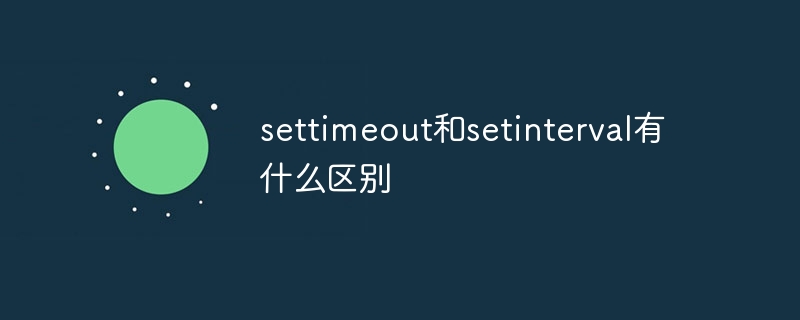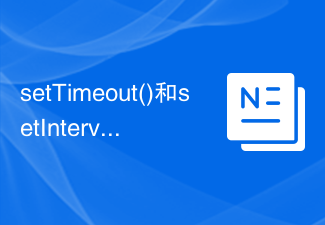 Web Front-end
Web Front-end JS Tutorial
JS Tutorial Do you really understand the difference between setTimeout and setInterval?_javascript skills
Do you really understand the difference between setTimeout and setInterval?_javascript skillsYou may even mistakenly interpret two functions that implement scheduled calls as something similar to threads, thinking that the called functions will be executed concurrently within a time slice. This seems very good and powerful, but in fact it is not the case. In fact, The situation is that javascript runs in the browser's javascript engine in a single-threaded manner. The function of setTimeout and setInterval is just to insert the code you want to execute into a code queue maintained by the js engine at a time point you set. , inserting the code queue does not mean that your code will be executed immediately, it is important to understand this. And setTimeout and setInterval are a little different.
Let’s talk about setTimeout first
function click() {
// code block1.. .
setTimeout(function() {
// process ...
}, 200);
// code block2
}
Suppose we give The onclick event of a button is bound to this method. When we press the button, the content of block1 will be executed first, and then run to the setTimeout location. SetTimeout will tell the browser, "After 200ms, I will insert a piece of code to be executed." "In your queue", the browser certainly agreed (note that inserting the code does not mean immediate execution). After the setTimeout code runs, the block2 code that follows starts to execute. This is where the problem begins. If the code of block2 If the execution time exceeds 200ms, what will be the result? Perhaps according to your previous understanding, you will take it for granted that as soon as 200ms arrives, your process code will be executed immediately... The fact is that during the execution of block2 (after executing 200ms) The process code is inserted into the code queue, but the process code segment will not be executed until the execution of the click method is completed. Judging from the code queue, the process code is behind click. In addition, js is executed in a single-threaded manner, so it should not be difficult. Understand. If it is another situation, the execution time of block2 code Look at setInterval
There may be two problems here:
1. The time interval may skip
2. The time interval may
function click() {
// code block1...
setInterval(function() {
// process ...
}, 200 );
// code block2
}
Same as above, we assume that through a click, setInterval is triggered to execute the process code every other time period

For example, onclick needs to be executed in 300ms, block1 code is executed, setInterval is executed at 5ms, and this is a time point. The process code is inserted at 205ms, the click code ends successfully, and the process code starts executing (equivalent to the figure) timer code), however, the process code also executed for a relatively long time, exceeding the next insertion time point of 405ms. In this way, another process code was inserted after the code queue, and the process continued to execute, and the insertion time of 605ms was exceeded. Click, here comes the question. You may also think that another process code will be inserted after the code queue... The real situation is that since there is already an unexecuted process code in the code queue, the insertion time is 605ms. The point will be "mercilessly" skipped, because the js engine only allows one unexecuted process code. I wonder if you will suddenly become enlightened after talking about this...
For this case you can use a better form of code
setTimeout(function(){
//processing
setTimeout(arguments.callee, interval);
}, interval);
I think if you think about this for a while, you will understand the benefits of it, so that there will be no problems with time points being skipped. That’s it. I hope it can be helpful. Maybe I didn’t express it very clearly. If you feel that your English is The basics are good and you can watch it directly

contains the section about advanced Timers. Personally, I think this book is really good. Whether you want to start from scratch, or you just need to look through it for reference. The author is from yahoo. A very good front-end development engineer: )
 settimeout和setinterval有什么区别Aug 15, 2023 pm 02:06 PM
settimeout和setinterval有什么区别Aug 15, 2023 pm 02:06 PMsettimeout和setInterval的区别:1、触发时间,settimeout是一次性的,它在设定延迟时间之后执行一次函数,而setinterval是重复性的,它会以设定的时间间隔重复执行函数;2、执行次数,settimeout只执行一次,而setinterval会一直重复执行,直到被取消。
 如何使用setInterval函数定时执行代码?Nov 18, 2023 pm 05:00 PM
如何使用setInterval函数定时执行代码?Nov 18, 2023 pm 05:00 PM如何使用setInterval函数定时执行代码?在JavaScript中,setInterval函数是一个非常有用的函数,它可以定时执行一段代码。通过setInterval函数,我们可以在特定的时间间隔内重复执行指定的代码。本文将详细介绍如何使用setInterval函数,并提供具体的代码示例。一、setInterval函数的基本语法如下:setInterv
 Window.setInterval()方法怎么使用Aug 31, 2023 am 09:33 AM
Window.setInterval()方法怎么使用Aug 31, 2023 am 09:33 AMWindow.setInterval() 方法的基本语法是“window.setInterval(function, delay)”,function是要重复执行的函数或代码块,delay是每次执行之间的时间间隔,以毫秒为单位。该方法是JavaScript中用于定时重复执行指定函数或代码的方法,它的使用非常简单,只需要传入要执行的函数或代码块以及重复执行的时间间隔。
 setInterval如何停止Dec 11, 2023 am 11:39 AM
setInterval如何停止Dec 11, 2023 am 11:39 AM可以使用clearInterval函数来停止由setInterval函数创建的定时器。setInterval函数会返回一个唯一的定时器ID,可以将该ID作为参数传递给clearInterval函数,以停止定时器的执行。
 setIntervalAug 02, 2023 am 10:17 AM
setIntervalAug 02, 2023 am 10:17 AMsetInterval函数是JavaScript中的一个定时器函数,允许你设置一个间隔,并在每个间隔之后执行指定的代码,需要定期处理某些任务或实时更新页面元素的情况非常有用,要注意使用setInterval时的性能和可靠性问题,并根据需要进行优化。
 setinterval用法详解Sep 12, 2023 am 09:55 AM
setinterval用法详解Sep 12, 2023 am 09:55 AMsetinterval用法是“setInterval(function, delay);”,“function”是要执行的函数,可以是函数表达式或函数引用,“delay”是执行函数之间的时间间隔,以毫秒为单位。setInterval是JavaScript中用于周期性执行代码的函数,它接受一个函数和一个时间间隔作为参数,会按照指定的时间间隔重复执行函数。
 setTimeout()和setInterval()在JavaScript中有什么区别?Sep 01, 2023 pm 03:01 PM
setTimeout()和setInterval()在JavaScript中有什么区别?Sep 01, 2023 pm 03:01 PMsetTimeout(function,duration)-该函数在duration毫秒后调用函数。这适用于一次执行。让我们看一个例子-它等待2000毫秒,然后运行回调函数alert(‘Hello’)-setTimeout(function(){alert('Hello');},2000);setInterval(function,uration)-此函数在每duration毫秒后调用function。这可以无限次进行。让我们看一个例子-它每2000毫秒触发一次警
 在JavaScript中使用clearTimeout函数取消setTimeout的计时器Nov 18, 2023 am 08:05 AM
在JavaScript中使用clearTimeout函数取消setTimeout的计时器Nov 18, 2023 am 08:05 AM在JavaScript中使用clearTimeout函数取消setTimeout的计时器,需要具体代码示例在JavaScript中,setTimeout函数是用来在指定的时间延迟后执行一次特定的代码。而setInterval函数则是用来在指定的时间间隔内重复执行一段特定的代码。然而,在某些情况下,我们可能需要在定时器执行之前取消它。在这种情况下,就可以使用c


Hot AI Tools

Undresser.AI Undress
AI-powered app for creating realistic nude photos

AI Clothes Remover
Online AI tool for removing clothes from photos.

Undress AI Tool
Undress images for free

Clothoff.io
AI clothes remover

AI Hentai Generator
Generate AI Hentai for free.

Hot Article

Hot Tools

EditPlus Chinese cracked version
Small size, syntax highlighting, does not support code prompt function

VSCode Windows 64-bit Download
A free and powerful IDE editor launched by Microsoft

ZendStudio 13.5.1 Mac
Powerful PHP integrated development environment

MantisBT
Mantis is an easy-to-deploy web-based defect tracking tool designed to aid in product defect tracking. It requires PHP, MySQL and a web server. Check out our demo and hosting services.

SublimeText3 Chinese version
Chinese version, very easy to use





